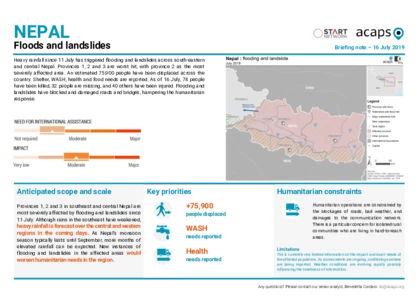Latest updates on country situation
10 May 2024
A household survey on around 305 households conducted in December 2023 in the earthquake-affected districts of Jajarkot and Rukum West revealed a significant loss of productive assets and damage to agricultural land, irrigation systems, animal shelters, and stocked fodder. The affected need food assistance, livelihood support, and land rehabilitation. (FAO 10/10/2024)
13 December 2023
More than 40,000 earthquake-displaced people in Karnali province are living in tarpaulin tents. They urgently need food, healthcare, and WASH assistance, as well as winterisation support, including adequate shelter, warm blankets, mattresses, warm clothes, stoves, and fuel. (The Guardian 12/12/2023, HRW 13/12/2023, Shelter Cluster 23/11/2015)
Analysis products
on
Nepal
07 October 2024
Nepal: Floods in central and eastern districts
DOCUMENT / PDF / 808 KB
Heavy rainfall on 27–28 September caused flash floods, the overflow of rivers, and landslides in 44 districts across Nepal, with the worst effects in the hilly Kathmandu Valley followed by the plains of eastern Koshi and Madhesh provinces, increasing their vulnerability to flooding.
10 November 2023
Nepal: earthquake in Jajarkot district
DOCUMENT / PDF / 284 KB
On 3 November 2023, a 6.4-magnitude earthquake hit the western area of Jajarkot district in Karnali Province. This is the deadliest earthquake to hit Nepal since 2015, when two earthquakes killed nearly 9,000 people near Kathmandu.
13 October 2020
COVID-19 and Migrant Vulnerability in Bangladesh, India and Nepal
DOCUMENT / PDF / 285 KB
This report aims to describe key factors affecting vulnerability for both internal and international labour migrants and the communities they are returning to in Bangladesh, India and Nepal, in order to support humanitarian and development actors to proactively identify and respond to emerging critical needs.
12 June 2020
Nepal: COVID-19 & the return of migrants
DOCUMENT / PDF / 369 KB
Many migrant workers, most of them from Nepal, lost their employment when the Indian governmentimposed a strict lockdown on 25 March to contain the spread of COVID-19. With theeasing of the lockdown, 600,000 migrant workers are expected to return to Nepal in the coming weeks andmay weaken the effectiveness of Nepal’s COVID-19 mitigation measures.
17 July 2019
Nepal: Floods and landslides
DOCUMENT / PDF / 482 KB
Heavy rainfall since 11 July has triggered flooding and landslides across south-eastern and central Nepal. Provinces 1, 2 and 3 are worst hit, with province 2 as the most severely affected area. An estimated 75,900 people have been displaced across the country. Shelter, WASH, health and food needs are reported. As of 16 July, 78 people have been killed, 32 people are missing, and 40 others have been injured. Flooding and landslides have blocked and damaged roads and bridges, hampering the humanitarian response.






